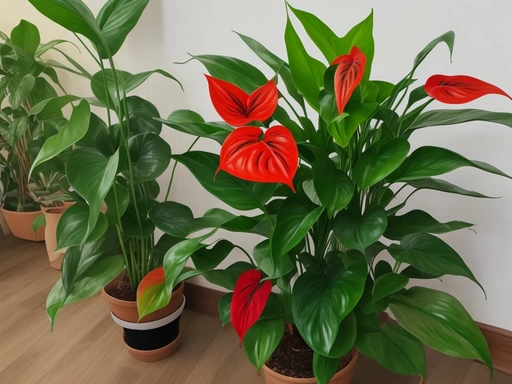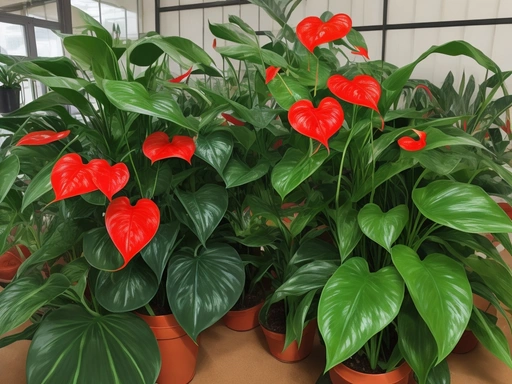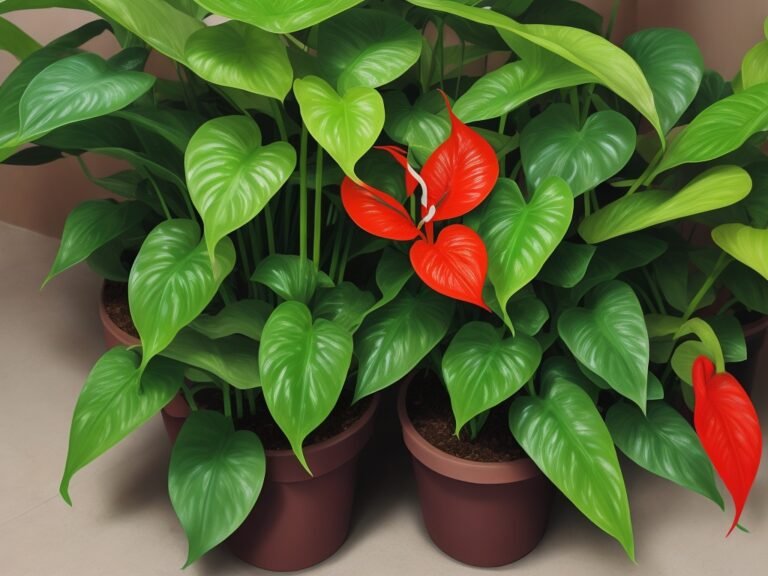Anthurium Humidity Needs – The Key to Thriving Anthuriums!
Key Takeaways:
- Anthurium plants thrive in high humidity environments.
- Keeping humidity levels between 60-80% is ideal for Anthuriums.
- Regular misting or using a humidifier can help maintain the required humidity level.
- Ensuring proper drainage and avoiding overwatering is crucial for Anthurium’s health.
Are you a plant lover looking to add a touch of tropical beauty to your indoor space? Look no further than the Anthurium plant.
With its vibrant and glossy heart-shaped leaves and stunning flowers in shades of red, pink, and white, the Anthurium is the perfect addition to any plant collection.
However, to keep this tropical beauty thriving, it’s essential to understand its humidity needs. In this article, I’ll dive into the importance of humidity for the growth of Anthurium plants, discuss the optimal humidity levels, and provide tips on maintaining the right humidity for these stunning plants.
So, let’s get started and create the perfect environment for your Anthurium to flourish!
| Humidity Level | Description |
| High humidity (60-80%) | Anthuriu ms thrive in high humidity levels, which mimic their natural tropical habitat. This level of humidity helps to keep their leaves shiny and prevents them from drying out. |
| Moderate humidity (40-60%) | While anthuriums prefer high humidity, they can tolerate moderate humidity levels as well. However, if the humidity drops too low for extended periods, the plant may suffer and show signs of stress. |
| Low humidity (<40%) | Anthuriums are not fond of low humidity levels, especially if it is combined with high temperatures. Low humidity can lead to leaf browning, tip necrosis, and overall poor plant health. |
What is Anthurium?
Anthurium is a beautiful tropical plant with vibrant, glossy leaves and striking, long-lasting flowers. It thrives in warm and humid environments, making it a popular choice for indoor decoration.
Anthurium: A Beautiful Tropical Plant
Anthurium is a stunning tropical plant known for its vibrant, heart-shaped flowers and glossy, dark green leaves. It adds a touch of exotic beauty to any indoor or outdoor space.
With proper care and attention to its humidity needs, Anthurium can thrive and bring joy to its owners.
Understanding Anthurium Humidity Needs
Understanding the humidity needs of anthurium is essential for their growth.
Humidity: A Key Factor for Anthurium Growth
Anthurium plants require a specific level of humidity for optimal growth.
Ideal humidity ranges from 60% to 80% for these tropical plants.
Maintaining proper humidity levels helps with leaf health, flower production, and overall plant vigor.
Low humidity can cause stress, resulting inensure the health of your Anthurium plant!– /wp:paragraph –>
On the other hand, high humidity can lead to fungal diseases and rot.
To maintain optimal humidity, you can use a humidifier or place a tray of water near the plant.
Misting the foliage can also help increase humidity temporarily.

Optimal Humidity Levels for Anthurium Plants
Anthurium plants thrive in humidity levels between 60% and 80%.
Ideal Humidity Range for Anthurium Plants
The ideal humidity range for Anthurium plants is between 50% and 60%.
This level of humidity mimics their natural tropical environment and promotes healthy growth.
Monitoring the humidity levels and keeping them within this range will help ensure your Anthurium thrives.
How to Measure Humidity for Anthurium Plants
To measure humidity for Anthurium plants, you can use a hygrometer.
This handy device measures the moisture content in the air.
Place the hygrometer near your plant to get an accurate reading.
You can also use a humidity sensor or a digital thermometer with a built-in humidity gauge.
Make sure to regularly check the humidity levels to ensure your Anthurium is happy and healthy.
Effects of Low Humidity on Anthurium Plants
Low humidity can have negative effects on Anthurium plants.
Signs of Low Humidity Stress in Anthurium Plants
Signs of low humidity stress in Anthurium plants include wilting leaves, brown leaf tips, slow growth, and increased susceptibility to pests. To address this, you can increase humidity by misting the plant, placing it on a tray of water, or using a humidifier.
Steps to Increase Humidity for Anthurium Plants
To increase humidity for anthurium plants, you can try these steps:
- Grouping plants together: Placing multiple plants close together creates a microclimate with higher humidity levels.
- Using a pebble tray: Fill a tray with water and place it under your plant pot. As the water evaporates, it increases the humidity around the plant.
- Misting the foliage: Lightly misting the leaves with water can provide temporary humidity relief, but avoid overdoing it to prevent waterlogged soil.
- Using a humidifier: If you have a larger space or multiple plants, a humidifier can effectively raise humidity levels. Make sure to choose one appropriate for the size of your room.
- Using a humidity tray: Place your plant pot on a tray filled with water and pebbles. As the water evaporates, it creates a humid environment around the plant.
Remember, maintaining optimal humidity levels is crucial for the health and growth of your anthurium plants. Regularly monitor the humidity and adjust these methods as needed to provide the ideal conditions.
Effects of High Humidity on Anthurium Plants
High humidity can negatively impact Anthurium plants, leading to issues such as root rot, fungal diseases, and poor growth.
Risks and Challenges of High Humidity for Anthurium Plants
High humidity can pose risks and challenges for Anthurium plants.
Excess moisture in the air can promote the growth of fungi, mold, and bacteria, leading to root rot and other diseases.
High humidity can also inhibit proper airflow and cause leaf drooping or yellowing.
Additionally, it may attract pests like spider mites.
Proper ventilation and humidity control are crucial to avoid these issues and ensure the health of your Anthurium plant.

Strategies to Reduce Humidity for Anthurium Plants
To reduce humidity for Anthurium plants, try these strategies:
- Provide proper ventilation by opening windows or using fans.
- Place a dehumidifier in the room to remove excess moisture.
- Avoid overwatering the plants to prevent moisture buildup in the soil.
- Use a well-draining potting mix to prevent water retention.
- Keep the plants away from sources of humidity like bathrooms or kitchens.
- Place the plants in a drier area or use a tray filled with pebbles and water to create a humidity-free zone for the plants.
Remember, maintaining proper humidity levels is crucial for Anthurium plants’ overall health and growth.
Maintaining Optimal Humidity for Anthurium Plants
Maintaining optimal humidity levels is essential for the health and well-being of your Anthurium plants.
Tips for Controlling Humidity Levels in Indoor Environments
To control humidity levels in indoor environments for your Anthurium plants, you can follow these tips:
- Use a dehumidifier: If the humidity is too high, a dehumidifier can help remove excess moisture from the air.
- Increase ventilation: Opening windows or using fans can help improve air circulation and reduce humidity levels.
- Use a humidifier: On the other hand, if the humidity is too low, a humidifier can add moisture to the air.
- Group plants together: Placing your Anthurium plants together can create a microclimate with higher humidity levels.
- Use a pebble tray: Placing your plant’s pot on a tray filled with water and pebbles can create additional humidity around the plant.
Remember, maintaining optimal humidity levels is important for the health and growth of your Anthurium plants.
Creating Humidity Microclimates for Anthurium Plants
To create humidity microclimates for Anthurium plants, you can try a few simple methods.
First, grouping your plants together helps create a localized humid environment.
You can also place a tray filled with water near the plants, as the water gradually evaporates, it increases the humidity.
Another option is to use a humidifier or mist the leaves regularly.
Just remember to avoid direct contact with water, as it can cause damage to the leaves.
Frequently Asked Questions about Anthurium Humidity Needs
What happens if I neglect Anthurium humidity needs?
Neglecting Anthurium humidity needs can lead to dry and stressed plants.
The leaves may become brown or yellow, and the plant may not produce new blooms.
Proper humidity is important for optimal growth and overall health.

Can I use a humidifier to improve Anthurium humidity levels?
Yes, using a humidifier can definitely help improve Anthurium humidity levels.
It is a simple and effective way to increase the moisture in the air around your plant, which is important for its growth and overall health.
Just make sure to set the humidifier to the appropriate humidity level for Anthurium plants, which is around 60-70%.
How often should I mist my Anthurium plant?
Mist your Anthurium plant 1-2 times a week. Mist the leaves, avoiding the flowers, and make sure the water droplets are small.
This will help maintain the desired humidity level and keep your plant happy and healthy.

Can I place my Anthurium plant in a bathroom with high humidity?
Yes, you can place your Anthurium plant in a bathroom with high humidity. Anthuriums thrive in humid environments, so the bathroom can provide the perfect conditions for their growth.
Just make sure they still receive adequate light and avoid placing them too close to drafts or temperature fluctuations.
Final Verdict
Understanding and meeting the humidity needs of your Anthurium plants is crucial for their growth and overall health. Maintaining optimal humidity levels, which range between 70-80%, will help promote lush foliage and vibrant blooms.
Low humidity can lead to stress and dehydration, while high humidity can create conditions ripe for disease and pests.
ensure your Anthurium plants thrivety levels, as well as implementing strategies like misting or creating microclimates, you can ensure your Anthurium plants thrive in their tropical environment. Don’t neglect their humidity needs, as it can make all the difference in their long-term success.







